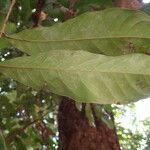A tree. It grows 30-45 m high. The trunk is straight or slightly tapered. It does not have buttresses but the roots are fluted at the base. The crown is flat. The leaves have 4-11 pairs of leaflets along the stalk and one at the end. The fruit are flat one-sealed pods.
Smooth pale flat 1-seeded fruits of horny consistence, tardily dehiscent.
Copious rather flat panicles of white, scented flowers
A large savannah tree, to 100 ft. high



